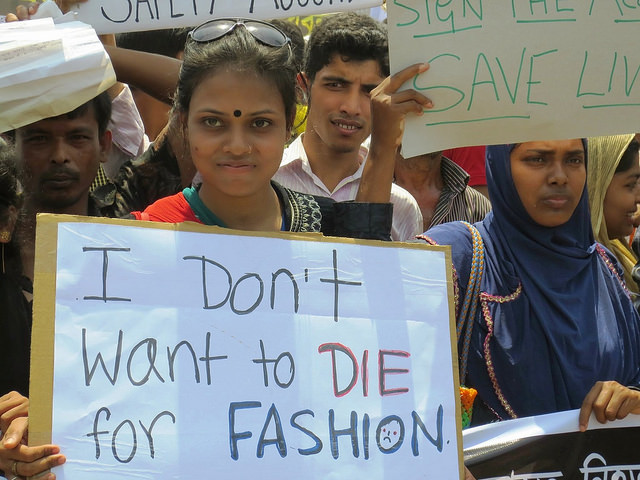
“There is no beauty in the finest cloth if it makes hunger and unhappiness.” ~ Mahatma Gandhi
There is something about buying a perfectly fitting new pair of jeans or a cute fall sweater that makes us feel all warm and fuzzy inside.
In the 70s, when marketing started to be employed by companies and brands they were all about what makes us, the consumer, feel good. Or making the consumer believe that “consuming” would make us feel good or satisfy a “need.”
As Jean Baudrillard a French sociologist, philosopher, and cultural theorist pointed out in his classic work The Consumer Society, we are all part of a system that has been carefully crafted by producers where at the end we are presented with a false sense of “freedom of choice” to consume a variety of objects.1
This system leads us to believe we can “prove ourselves” by consuming these objects, what he calls “salvation by consumption.”
It was only the year 1970 when Baudrillard wrote this important piece on the meaning of consumption in contemporary culture, but we can clearly see how it still holds up today, more than ever.1 Since many of us feel reaffirmed when buying a garment, and may not think of how it made it to our hands.
Fashion is not what it used to be.
Today the fashion industry has truly evolved into something enormous, chains like ZARA, H&M, Topshop, and GAP rule the world of fast fashion, and also the financial world. The creator of Zara, Amancio Ortega, now disputes Bill Gates as the richest man in the world, being valued at $74.4 billion dollars.3
Fast Fashion puts an emphasis on optimizing certain aspects of the supply chain in order for the clothes to be designed and manufactured quickly and inexpensively so that consumers can buy current clothing styles at a lower price.
This means that the price is low—but we are not taking into account other “costs.”
The industry has grown into something we probably never imagined. The resources and the ecological impact that it’s having on nature and on the humans that actually produce the garments is astonishing. For example, the textile industry creates 2.5 billion pounds of used clothing that ends up in landfills around the world each year. 3 Polyester is 40-45 percent of all the fabric that is produced around the world, and is made of crude oil. 3 Polyester fabrics can take anywhere from 20-200 years to biodegrade!
As I learned more about this subject, I realized there are many facts we do not know. But when I read an article in one of my favorite eco-fashion blogs, about the death of textile worker in Bangladesh, tears just ran down my face. A nine-year-old boy named Sagar was found dead in a textile mill this July after being tortured to death by the supervisors at the mill. 4 Nearly 30 more children ages between 10 and 13 were rescued when police raided the mill that produces yarn for clothing factories in Bangladesh.5 After this brutal incident, hundreds of citizens took to the streets in a suburb of the Bangladeshi, capital of Dhaka, to protest this and other similar deaths to children that happened that year in factories. Another tragedy was the 2013 Rana Plaza incident (also in Bangladesh) where a building that housed textile factories collapsed killing 1,137 workers.6
All of this left me in shock, I could not help but think that most Westerners have no idea where or under what conditions their clothes are made. I wondered that if all the consumers knew about these injustices would we allow all of this injustice to happen without expressing any concern at all?
I don’t think so.
People are rising up.
After digging more deeply, I was relieved to find I am not alone in asking these questions. There is a whole movement rising against fast fashion. The reason is simple, as mentioned by John Hilary in the inspiring new documentary, The True Cost.
“When everything is concentrated on making profits what you see is that Human Rights, the environment, Worker’s Rights get lost.” ~ John Hilary, The True Cost
This documentary by Andrew Morgan is a must-see to understand the situation more clearly. It unites fashion experts and activists like John Hilary, Director of War on Want to unveil the world of Fast Fashion. 7
It’s good to know that there are also organizations like Clean Clothes Campaign that focus on improving working conditions in the garment industry. Others include Greenpeace, Fair Trade USA, The Good Trade and Fashion Revolution.
As far as where to buy ethically made clothes, there are many brands sprouting up that support fair trade, organic/biodegradable materials and fair working conditions for their workers.
We really have no excuse to turn a blind eye to this situation—we can still turn it around.
Here are some ethical brands which include sportswear and children’s brands that you can buy online: 8
References
1. The Consumer Society, Paris: Gallimard, 1970.
- “Fast Fashion” Made These Men Some of the Planetʼs Richest by Jasmin Malik Chua. www. ecouterre.com
- 22+ Things You Didn´t Know About The Fashion Industry (Part II) by Taylor Thompson, akindjourney.com
- 9-Year-Old Child Worker Dies in Textile Mill in Bangladesh by Jasmin Malik Chua. www. ecouterre.com
- Bangladeshis Protest Hideous Murder of 10-Year-Old Boy
- Rana Plaza collapse: dozens charged with murder, Associated Press in Dhaka
- The True Cost, Andrew Morgan, 2015
- http://www.thegoodtrade.com/features/fair-trade-clothing
Author: Ceci Trigos
Image: Solidarity Center at Flickr
Editor: Renée Picard






Read 9 comments and reply